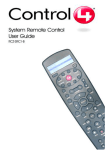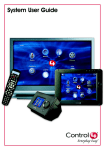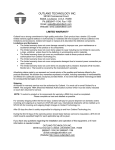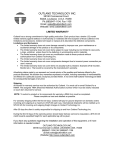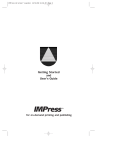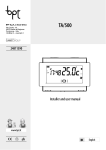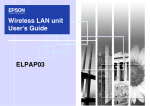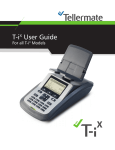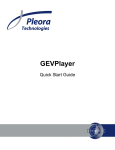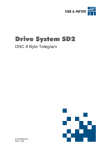Download Control 4 RCZ-SRC1-B User guide
Transcript
System Remote Control Version 2 User Guide Disclaimer Control4® makes no representations or warranties with respect to any Control4 hardware, software, or the contents or use of this publication, and specifically disclaims any express or implied warranties of merchantability or fitness for any particular purpose. Control4 reserves the right to make changes to any and all parts of Control4 hardware, software, and this publication at any time, without any obligation to notify any person or entity of such changes. Trademarks Control4 is a registered trademark of Control4 Corporation. Other product and company names mentioned in this document may be the trademarks or registered trademarks of their respective owners. Copyright Copyright © 2004-2007 Control4 Corporation. All rights reserved. No part of this publication may be reproduced, photocopied, stored on a retrieval system, or transmitted without the express written consent of the publisher. Control4 Corporation 11734 S. Election Road, Suite 200 Salt Lake City, UT 84020 USA http://www.control4.com System Remote Control Version 2 User Guide Part Number: 200-00011 Rev A Hardware Model Number: RCZ-SRC2-B ii Contents Chapter 1 Get Started ....................................1 Uses and Features ........................................1 About the Modes ...........................................2 What’s New in this Model ..............................4 Install and Maintain Batteries ........................6 About System Remote Control RCZ-SRC2-B .................................................7 Chapter 2 Use the Remote Control ............17 Use Remote with On-Screen Navigator ......17 Use LCD Navigator......................................19 Control Devices ...........................................19 Chapter 3 Regulatory Info ...........................21 Regulatory Compliance ...............................21 iii iv CHAPTER 1 Get Started Uses and Features Control4 System Remote Control Version 2 (model # RCZSRC2-B) is intended for use in a Control4® system. It is included with the purchase of a Media Controller or Home Theater Controller, but may also be purchased separately. This remote control can be used to: • • • Navigate system menus and access media databases on a television or monitor Navigate system menus and access media databases in its own LCD window Control system devices This remote control goes beyond a typical “universal” remote that simply learns IR codes from TVs, VCRs, CD players, and DVD players. Features of this device include: • • • • • • • • • Bi-directional communication with system components ZigBee wireless mesh networking LCD with menu that provides full system access LCD back-lighting for ease of use in dark rooms Media playlists and playing options for stored media One-button push to control systems (such as music, television, or videos) Ergonomically designed for comfort Standard control features for: Digital Satellite Systems (DSS), Cable Boxes, TV Tuners, Digital Video Recorders (DVR), DVD Players or Changers, VCRs, TVs, MP3 Players or CD Players or Changers Powered by four AAA batteries (included) About the Modes This remote control supports three different modes of operation: • • • On-Screen Navigator mode: In this mode you access and control all system devices through a monitor or TV on-screen menu (On-Screen Navigator). the Control4 button to access the OnPress Screen Navigator home page (or main menu) and then press a system button (such as Radio or TV) to display the specific submenu on the TV screen. LCD Navigator mode: In this mode you access all system components through the LCD menu. Press the LCD button to enter LCD Navigator mode and display a menu in the LCD and press Cancel to exit. Once you choose a media source (broadcast or stored), the remote enters Device-Control mode and allows you to control the device associated with the selected media. Note: The LCD goes to sleep after 15 seconds of inactivity and it will wake up with any button press. Device-Control mode: In this mode you use the System Remote Control to control the selected device. When devices in the room are off, press RADIO, MUSIC, TV, or VIDEOS button to enter the DeviceControl mode and begin controlling one of the associated devices. By default, it will be the most recently used device (such as Multi Tuner) for the selected system (such as Radio) in the current room. The remote control will continue to control the current device until another device is accessed. The current mode affects the remote control behavior. The following table shows a high-level summary of how functionality differs from mode to mode. 2 Remote Control Section: On-Screen Navigator mode: LCD Navigator mode: Device-Control mode: LCD NA Displays LCD menus related to current system. NA NA NA System Buttons If a video device is currently on, press one to display systemspecific menu on the TV. Press one to display systemspecific menu in the LCD and to choose the device or playback to be controlled. Press Radio, Music, TV, or Videos to start the selected system and control play. Navigation Buttons Use arrows to move through the LCD menu levels or press Select to choose the highlighted item. Use buttons to control sound, change channels, or view information about current media or broadcast. Control Buttons NA NA Control current device or playback. Numeric Keypad Use numbers to Enter specific TV select lighting channel number or, if levels. device-specific programming is present, press * or # to run. Control4 Button 123 Press to view On-Screen Navigator on your monitor/TV. Use arrows to move the highlighter on the TV around or press Select to choose the highlighted item. NA Press A, B, C, or D to run room-specific or device-specific program. 3 What’s New in this Model System Remote Control Version 2 (Model # RCZ-SRC2-B) is the next generation of Control4 system remotes: • • • We renamed, relocated, and replaced several buttons. We replaced black rubber with light, glow-in-the-dark rubber. We added device-level programmable buttons so that installers could program one-button shortcuts. Table 6–1 summarizes changes from Version 1 to 2. TABLE 6–1. CHANGES TO BUTTONS AND FUNCTIONS Was...RCZ-SRC1-B: Now is...RCZ-SRC2-B: Old Button Name and Function New Button Name and Function POWER OFF Turned off all A/V devices in room. Turns off all A/V devices in room. DISPLAY Provided access to Configuration menu for the LCD. LCD Enters LCD Navigator mode: Displays top menu of LCD Navigator in the LCD. Note: The Configuration menu for the LCD is now located under “Info” in LCD Navigator. RADIO, MUSIC, TV, and VIDEOS RADIO, MUSIC, TV, and VIDEOS • • 4 Short press entered LCD Navigator mode: Displayed chosen system menu in LCD and chose the device to be controlled. Long press when a TV was on would display the chosen system options on top of the current display on the TV. • • Initial press provides shortcut to the selected system—puts remote control into Device-Control mode and turns on the last used source (such as a TV tuned to the last TV broadcast). The Room name and current device display in the LCD. Subsequent presses toggle through available sources for the selected system (such as alternative TV sources). Was...RCZ-SRC1-B: Now is...RCZ-SRC2-B: Old Button Name and Function New Button Name and Function COMFORT, LIGHTS, HOUSE, and INFO COMFORT (A), LIGHTS (B), HOUSE (C), and INFO (D) • Short press entered LCD Navigator mode: Displayed chosen system menu in LCD and chose the device to be controlled. Long press when a TV was on would display the chosen system options on top of the current display on the TV. • • If in On-Screen Navigator mode, these buttons provide shortcuts to their system’s On-Screen menu (Comfort, LIghts, House, or Info). If in LCD Navigator mode, these buttons provide shortcuts to their system’s LCD menu (Comfort, LIghts, House, or Info). If in Device Control mode, these buttons can be used as A, B, C, or D---programmable buttons that may have custom shortcuts for the room or current device. • • CHANNEL + Page up/down for satellite & Cable Arrows are changed to +/-, PAGE label menuing. on top case is changed to "CHANNEL". Now functions as channel up and channel down for appropriate devices. PAGE PIP and MENU PAGE Picture in picture button; Menu button for appropriate devices. Up and Down arrows are printed on the old PIP and MENU buttons respectively. Functions as Page up/ down for satellite & cable menuing. BACK MENU A Back button for menu navigation Functions as Menu button for with back arrow printed on button. appropriate devices. * * # Device-specific behavior # Available for custom programs Device-specific behavior Available for custom programs 5 Install and Maintain Batteries AAA + - AAA + Install the four AAA batteries (included with the product) into the back of the device. Ensure that you insert them into the remote control according to the diagram provided in the battery compartment (with the + and - terminals aligned correctly). - Install Batteries • • Keep battery contacts and compartment clean. Remove batteries from the remote control if it is not expected to be in use for several months. Extreme temperatures reduce battery performance. Avoid putting the remote control in very warm places. + + • AAA AAA - Use and Care Tips Replacement Safety Rules CAUTION! To prevent battery shorting, leakage or rupture: 6 • Use typical AAA Alkaline batteries only in the remote control. • Do not mix battery types, such as Alkaline and rechargeable NiMH batteries. • Do not attempt to recharge a battery unless the battery is specifically marked “rechargeable.” • Never dispose of batteries in a fire. About System Remote Control RCZ-SRC2-B System Remote Control Model #RCZ-SRC2-B can be divided into these sections: 1. LCD, LCD Button, and Off Button 2. Control4 Button and System Buttons (also referred to as the “Circle of Power” buttons) 3. Navigation Buttons 4. Device Control Buttons 5. Keypad Once the system setup is complete, the remote control responds to each buttonpress in a different way— depending on: • • • • • mode of remote control current location devices available in the current location when the button is pressed if the button has been programmed for a custom function 1 2 3 4 5 7 LCD, LCD Button, and Off Button LCD (liquid crystal display)—Provides information related to system activity. The LCD uses highlighting to show a selected item. It includes a white backlight that stays on for 15 seconds after a button is pressed. LCD button—Changes the remote mode to LCD Navigator mode and displays the menu in the LCD. See “Use LCD Navigator” on page 19). OFF button—Turns off all A/V devices in the current room. 8 Control4 Button and System Buttons Control4 button—If a TV or monitor (TV device) is available in the current location, it puts the remote control in On-Screen Navigator mode and displays the OnScreen menu on the TV device. The On-Screen Navigator display: displays the current location, provides access to additional locations, and provides access to all systems available at the current location. From here you can use the remote control navigation buttons to choose On-Screen Navigator options. Note: For more information on using On-Screen Navigator, refer to the Control4 System User Guide. 9 System buttons (or “Circle of Power” buttons)— The buttons surrounding the red Control4 button (Radio, Music, TV, Videos, Comfort [A], Lights [B], House [C], and Info [D]) are system buttons that respond differently depending on when they are pressed and if and how they have been programmed, as described in the remainder of this section: Radio When the remote control is in a Navigator mode (when either On-Screen Navigator or LCD Navigator are active), the RADIO Button acts as a shortcut into the radio submenu in the appropriate navigator. When devices in the room are off or the remote control is in Device-Control mode (when no Navigator screen is active), the RADIO button functions as a Quick Access button: Press it to start playing the radio and to be able to control the radio source with the device-control buttons. Initial Press of RADIO button: • • Turns on the last used radio source, tunes to the last used station on that source. The remote enters device-control mode for the current radio source. The LCD shows current room and current radio source. Subsequent Presses of RADIO button prior to LCD time-out: • 10 Additional presses toggle through the radio sources listed in the LCD and turns them on. When the last radio source is displayed, the next press loops back to the first available source. Music When the remote control is in a Navigator mode (when either On-Screen Navigator or LCD Navigator are active), the MUSIC Button acts as a shortcut into the music submenu in the appropriate navigator. When devices in the room are off or the remote control is in Device-Control mode (when no Navigator screen is active), the MUSIC button functions as a Quick Access button. Press it to start playing music and to be able to control the music source with the device-control buttons. Initial Press of MUSIC button • • • Turns on the last used music source and begins playing music from the last-played entry in the music queue, or from the analog source. If the music queue is empty, or if there is no media in the analog source, then the button press just turns on the music source. The remote enters device control mode for the music source. The LCD shows current room and current music source. Subsequent Presses of MUSIC button prior to LCD time-out • Additional presses toggle through the music sources listed in the LCD and turns them on. When the last music source is displayed, the next press loops back to the first available source. 11 TV When the remote control is in a Navigator mode (when either On-Screen Navigator or LCD Navigator are currently displayed), the TV Button acts as a shortcut into the TV submenu in the appropriate navigator. When devices in the room are off or the remote control is in Device-Control mode (when no Navigator screen is active), the MUSIC button functions as a Quick Access button. Press it to turn on the TV and to be able to control the TV with the device-control buttons. Initial Press of TV button • • Turns on the TV and selects the last broadcast source used. The remote enters device control mode for the TV & broadcast source. The LCD shows current room and current TV source. Subsequent Presses of TV button prior to LCD timeout • Additional presses toggle through the TV broadcast sources listed in the LCD and turns them on. When the last TV broadcast source is displayed, the next press loops back to the first available source. Videos When the remote control is in a Navigator mode (when either On-Screen Navigator or LCD Navigator are currently displayed), the VIDEOS Button acts as a shortcut into the video submenu in the appropriate navigator. When devices in the room are off or the remote control is in Device-Control mode (when no Navigator screen is active), the VIDEOS button functions as a Quick Access 12 button. Press it to begin playing a video and to be able to control the video source with the device-control buttons. Initial Press of VIDEO button • • Turns on the audio endpoint for the room and the last video source used. The remote enters device control mode for the video source. The LCD shows current room and current TV source. Subsequent Presses of VIDEO button prior to LCD time-out • Additional presses toggle through the video sources listed in the LCD and turns them on. When the last video source is displayed, the next press loops back to the first available source. Comfort (A), Lights (B), House (C), and Info (D) Note: Notice that the Comfort, Lights, House, and Info buttons have the additional labels A, B, C & D directly on the buttons. The additional labeling is related to custom programming that may be provided by your installer. When the remote control is in a Navigator mode (when either On-Screen Navigator or LCD Navigator are currently displayed), each of these 4 buttons acts as a shortcut into its related submenu in the appropriate navigator. For example, if the On-Screen Navigator Home page is displayed on the TV and you press Comfort (A), then a menu bar (submenu) similar to the following displays. 13 When devices in the room are off or the remote control is in Device-Control mode (when no Navigator screen is active), pressing one of these buttons will run the custom program assigned to that button for the current room or device. Ask your installer about custom programming or see Custom Button labels in the House menu: Button: Custom program for Room or Device control A: ______________________________________ B: ______________________________________ C: ______________________________________ D: ______________________________________ In the absence of custom programming, a button-press will only wake up the LCD to display the name of the current room and the “Options” pull-down menu option. 14 Navigation Buttons The following buttons are for screen and menu navigation. • • • • PAGE Page Up/Down MUTE Mute audio RECALL Toggle to previous channel INFO Current channel and program information • • • VOLUME - + Control volume Menu/Option Navigation SELECT Choose the highlighted item • • • • CHANNEL + Channel Up/ Down GUIDE Program listings CANCEL Clears screen of navigation information MENU Options for current location 15 Device Control Buttons These familiar buttons are for device control. • • • • • • • • • DVR (Digital Video Recorder) BACK l NEXT l REW PAUSE ll FWD STOP RECORD Q PLAY Keypad The alphanumeric keypad is for changing TV channels, setting lighting levels, or entering text. The * and # keys are available to the installers for custom programming. Ask your installer if a custom program is present or see Custom Button labels in the House menu: Button: Custom program for Room or Device control * : ______________________________________ # : ______________________________________ 16 CHAPTER 2 Use the Remote Control Here are basic use instructions for the three remote control modes: • • • “Use Remote with On-Screen Navigator” on page 17 “Use LCD Navigator” on page 19 “Control Devices” on page 19 For specific, task-oriented instructions, refer to the Control4 System User Guide. Use Remote with On-Screen Navigator Note: This document explains only general access to On-Screen Navigator. For specific instructions, refer to the On-Screen Navigator sections in the Control4 System User Guide. Note: If the video device connected to the controller (such as Home Theater Controller or Media Controller) is already on, press a system button to display the associated system menu on top of the current video display. 1 Press (the Control4 button) to access the OnScreen Navigator menu on the monitor or TV. 2 To navigate or choose an On-Screen Navigator item, (on the monitor or TV), use the arrows and Select button to move the cursor around the screen and choose an option. 3 Refer to Control4 System User Guide for user instructions. 18 Use LCD Navigator Use LCD Navigator to choose a variety of options. 1 Press the LCD button to choose LCD Navigator mode and view the system menu. 2 Use the arrows choose a system: House Lights Music Videos 3 and Select button to TV Radio Comfort Info Explore the system’s submenu (such as Comfort in the following example). Control Devices Choose a Device to Control To use this remote control to control system devices, you must first choose a system device using On-Screen Navigator, LCD Navigator, or by pressing a System button 19 on the remote that has been associated with a controllable device. Radio, Music, TV, or Videos: When the devices in the current room are OFF, the Radio, Music, TV, or Videos buttons function as a Quick Access button to DeviceControl mode. Press one of them once to start playing the most recently played source for that system, or press the same button again to choose the next available source for that system. For example, in a room where the DVD player was the most recently used Video source, but there is also a VCR, you would press Videos once to begin controlling the DVD player OR press Videos twice to toggle to the VCR and begin controlling the VCR. Alternatively, when using On-Screen Navigator or LCD Navigator to choose a media source (such as a broadcast channel, an album, or a movie), you automatically place the remote control in Device-Control mode. Use Device-Controls on the Remote Control Use the applicable remote control buttons to operate a supported third-party device. For example: If you pressed the Music button system button, then you can control the audio playback using the Control buttons on the remote control. 20 CHAPTER 3 Regulatory Info Regulatory Compliance North America This product complies with standards established by the following regulatory bodies: • • FCC Industry Canada FCC FCC ID: R33050110011: This device complies with Part 15 of the FCC Rules. Operation is subject to the following two conditions: (1) this device may not cause harmful interference, and (2) this device must accept any interference received, including interference that may cause undesired operation. This equipment has been tested and found to comply with the limits for a Class B digital device, pursuant to Part 15 of the FCC Rules. These limits are designed to provide reasonable protection against harmful interference in a residential installation. This equipment generates, uses, and can radiate radio frequency energy and, if not installed and used in accordance with the instructions, may cause harmful interference to radio communications. However, there is no guarantee that interference will not occur in a particular installation. If this equipment does cause harmful interference to radio or television reception, which can be determined by turning the equipment off and on, the user is encouraged to try to correct the interference by one or more of the following measures: • • • • Reorient or relocate the receiving antenna. Increase the separation between the equipment and receiver. Connect the equipment into an outlet on a circuit different from that to which the receiver is connected. Consult the dealer or an experienced radio/TV technician for help. IMPORTANT! Changes or modifications not expressly approved by Control4 could void the user’s authority to operate the equipment. Industry Canada This Class B digital apparatus complies with Canada ICES-003. Cet appareil numérique de la classe B est conforme à la norme NMB-003 du Canada. 22 CE Declaration of Conformity DeClaration OF CONFORMITY Control4 Corporation 11734 S. Election Road, Suite 200 Salt Lake City, UT 84020-6432 Tel (801) 523-3100 Product: System Remote Control Model No: RCZ-SRC2-B The undersigned hereby declares, on behalf of Control4 Corporation, that the above-referenced product, to which this declaration relates, is in conformity with the provisions of: Council Directive 89/336/EEC (May 3, 1989) on Electromagnetic Compatibility Council Directive 1999/5/EC (Mar 9, 1999) on Radio & Telecommunication Terminal Equipment (R&TTE) Council Directive 73/23/EEC (Feb 19, 1973) on Low Voltage Equipment Safety Council Directive 93/68/EEC (Jul 22, 1993) Amending Directives 89/336/EEC and 73/23/EEC and has been tested to the requirements of, and shown to be in compliance with, the following requisite standards: 23 EMC EN 301 489-1 V1.4.1 — Electromagnetic compatibility and Radio spectrum Matters (ERM); ElectroMagnetic Compatibility (EMC) standard for radio equipment and services–Part 1 Common technical requirements. EN 301 489-17 V1.2.1 — Electromagnetic compatibility and Radio spectrum Matters (ERM); ElectroMagnetic Compatibility (EMC) standard for radio equipment and services; Part 17: Specific conditions for 2.4 GHz wideband transmission systems and 5 GHz high performance RLAN equipment. AS/NZS CISPR 22: 2002 — Information Technology Equipment – Radio disturbance characteristics. Radio EN 300 328-2 V1.4.1 — Wide band transmission systems; data transmission equipment operating in the 2.4GHz ISM band. Harmonised EN covering essential requirements under Article 3(2) of the R&TTE Directive. AS/NZS 4771: 2000 — Spread Spectrum Equipment using 900MHz, 2.4GHz and 5.8GHz bands. Safety IEC 60950-1: 2001 (1st Edition) and/or EN 60950-1: 2001 — Information Technology Equipment—Safety with national and group differences in accordance with CB Bulletin No. 109A December 2005: AS/NZS 60950-1: 2003. The Technical Construction File required by these Directives is maintained at the corporate headquarters of Control4, Salt Lake City, Utah, U.S.A. Signed, Paul E. Nagel—Vice President of Engineering, January 26, 2007 Recycling For information on recycling, please go to www.control4.com/recycling 24




























